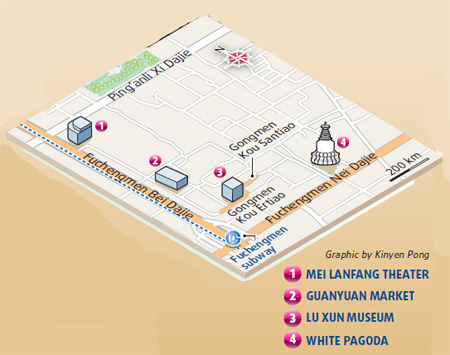
The road to Lu Xun Museum can be reached if you walk west through Gongmenkou Santiao. Here construction workers give some of the rag-tag siheyuan in the area a facelift. The easier option is to take the first wide road on your left as you come out of Fuchengmen Subway. The museum (19 Ertiao, Gongmenkou, Fuchengmennei Dajie) built around the residence of the writer of radical texts such as The True Story of Ah-Q, based on the Revolution of 1911, houses an enormous collection of books, manuscripts and personal effects.
Walk west till you reach Fuchengmen Beidajie, and then walk north along the shady boulevard, watching the elderly people playing board games, sitting on benches on either side of the garden path. A little further ahead on your right is Guanyuan Market, packed tight with live merchandise. The first 100 m is like a walk under the sea, with flaming orange goldfish, guppies and swordtails swishing past, checking out the human exhibits. Once you go out the south exit of the market and turn left to reach its back alley, the assortment of rosaries, dried bird nests, newborn kittens, bonsai, and pied grasshoppers held in cute little cages hits you in the face. Sales are brisk and the peddlers cry out their prices with total disregard for onlookers with a touristy interest. From this theater of life to the awesome concave glass structure of the Mei Lanfang Theater, sprawling like an illuminated ship deck and its spit-polished interiors, upholstered in velvety red, is only 250 m up north.
(China Daily August 11, 2009)